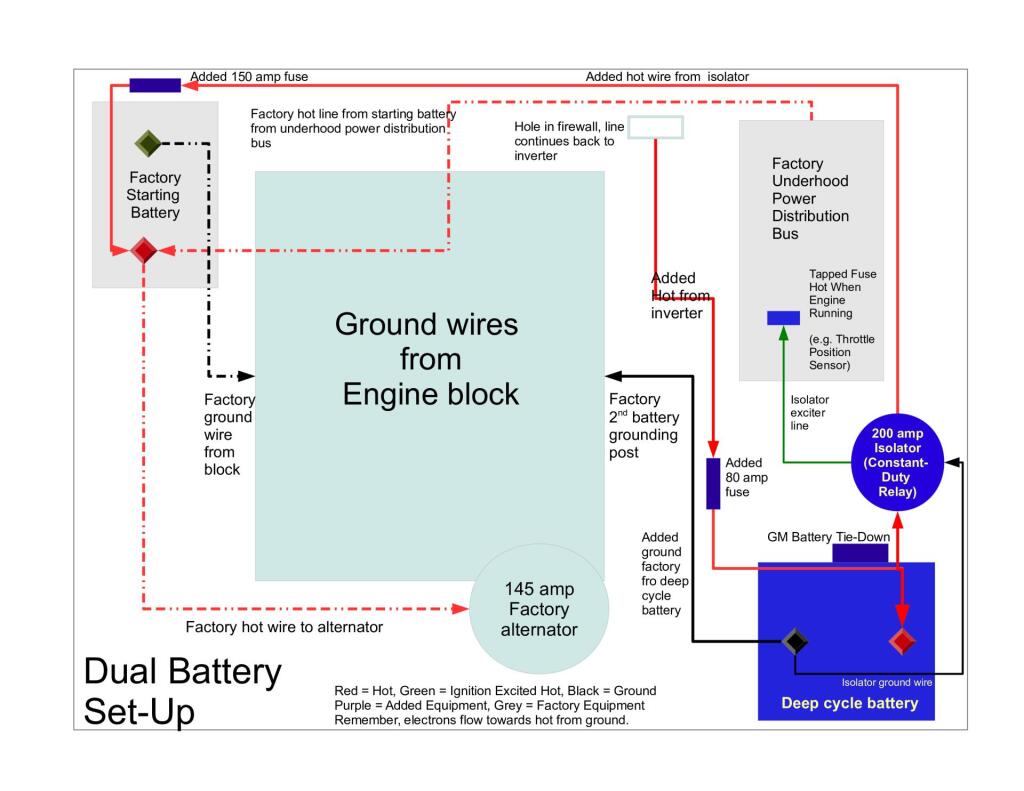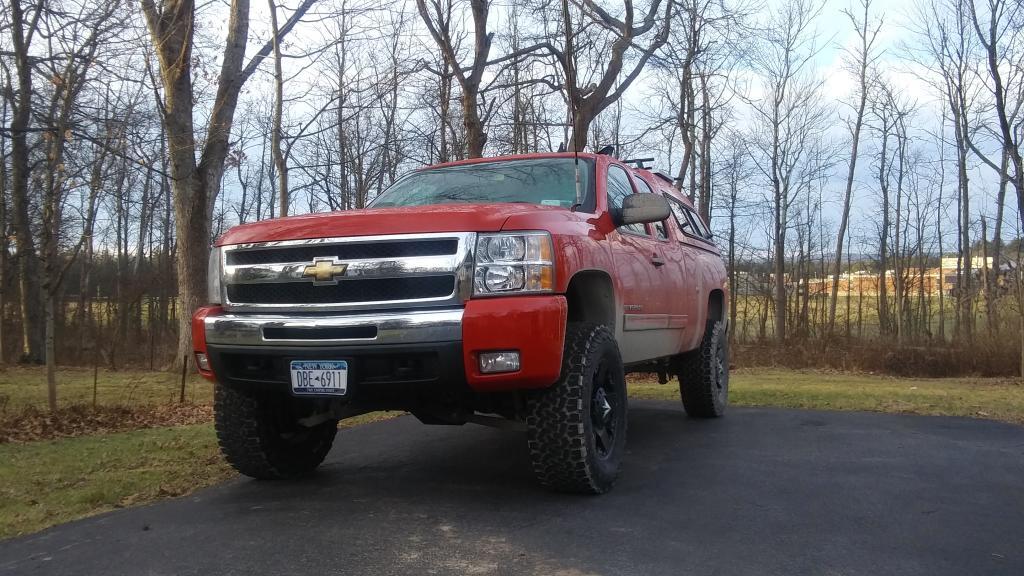Big Red
Back on the road, with big shinny new BFG tires, all muddy from Monday. I thought about washing it but then I remembered my weekend into next week plans. Hopefully he'll run better now for a while.
Wednesday December 15, 2021 — Big Red
Decided to Try to Keep Big Red for Another Year 
November 30th is a big decision day for me — to renew or not to renew the 1-year certificate of deposit that I have about $70k of cash invested in. If I renew the certificate of deposit, then I won’t be able to necessarily get a new truck next year if I need one.
But do I need a new truck?
The answer is probably not. Big Red is 12 years old, going on 13 years next October. He has about 107,000 miles on him, which by auto standards isn’t that old. For the most part he’s running pretty good. The 35 inch tires I put on Red two years ago now, are still in good shape. No signs of unsual wear or alignment issues on the truck. Red hasn’t been burning much oil lately, doesn’t have any new or unusual noises, has about as much rust as you might think of a vehicle through 12 harsh salty winters.
The usual issues for an older lifted truck — the power windows and seats don’t work perfectly, rusty wheel wells and corner panels, the one tail light leaks water and has to be emptied from time to time to keep the bulb from burning out, after I had the coolant changed the first few times I used the heater I could smell coolant thinking the flush might have caused a leak, the ball joints creek and grone when I crank the wheels tight to get into a tight spot, and the shocks and struts are pretty worn, especially noticeable in the rough country. The 5.3l engine, like most of them, has a lifter that ticks, especially when cold and left at idle speed for a prolonged time. But it’s been doing that for a decade plus now. They all do it to some extent. When the transmission is cold, the 2-3 shift can be a bit rough, a sign that the 460LE tranny is wearing out and not perfectly healthy but probably has a bit more life left in it. Also, not a brand new behavior. I had the transmission fluid changed at 50k, I could do it again, but it’s a expensive process as the pull the whole case off to get the filter, and my local mechanic doesn’t do it. I concede it ain’t going to last forever.
That’s everything I’m aware of, there are probably other issues too.
The thing is I probably can get another year out of it. The more I get out of Big Red, the more economical it will be. New trucks are so expensive, especially compared to 12 years ago. I make a lot more money these days, but still. I am not planning a West Virginia trip next year, due to my busy work schedule next year, probably the farthest I’ll get is the Finger Lakes. If I notice any new odd behaviors or noises, I’ll drop the truck off at my local mechanic to look it over carefully. It’s a risk to try to keep Big Red on the road for another year until December 2024 but with clear rewards in financial savings.
I am not in the place where I would be stranded without a vehicle, as I live in the city. There are towing and repair costs should Big Red break down on a road trip, and costs to rent a car or finding lodging. Though if I am only going out to the Finger Lakes at the farthest, the truth is I could always rent a car for the a few days and if necessary camp in a tent or stay at a motel somewhere. All cheaper then buying a new vehicle. There is no guarantee that my old truck is going to break down on a trip, indeed probably the odds are against that. I had a wonderful trip down to West Virginia followed by Madison County with no issues at all whatever.
The thing to is that breaking a one-year certificate of deposit isn’t that costly should for some reason Big Red break have to be replaced. The only way you end up losing some principal is if you break the CD between the end of the grace period and first quarter of the CD. Beyond the first quarter, you only really risk losing a portion of the accumulated interest over the most recent few months. But the thing about breaking a CD, according to the terms, is you only loose what you pull from the CD — you don’t have to cash out the full CD and only are penalized on what you remove prior the maturity date. And that 5% interest rate on one-year CD is quite attractive, even if it’s not that much over the high-interest savings account I also have with that firm. I wouldn’t have to break the even much of that CD, as I have nearly $40k in high-interest savings, and maybe not even touch it at all with the trade in on Big Red and choosing a smaller, more affordable truck or even car. Another option would be to cash in savings bonds or even sell stock, although the later option is likely a last resort, even though the markets have been up.
Committing to keep Big Red on the for another year, is a bit of a leap of faith that he’ll keep pushing on but compared to situation a lot of people are in when it comes to cars, I can’t be that worried or upset. I won’t need to get an auto loan most likely, and the worse that would happen is I loose a couple hundred bucks of interest by choosing to renew the certificate of deposit. I like Big Red and I’d loathe to give him up at this point, even if he is a bit expensive to operate and long in the tooth. Plus I am not totally sure I would want to replace Big Red with — do I want to get an electric car, a smaller pickup like a Toyota Tacoma that is fuel efficient and easier to get in and out of campsites and truck trails, or do I want the room of a 3/4 ton long bed truck? And moving to that new office in suburbs, I could decide to start driving to work to avoid transferring buses, so I might want a fuel efficient or electric vehicle for such a trip.
Honestly, I don’t know.
I think for now I am committed to Big Red. He’s taken me on a lot of good adventures. I concede he won’t last forever, but I should enjoy the good times while they still roll along. Keeping Red on the road is the most economical option, even if it comes with risks, like with any older vehicle. Repair is better then discard and replace it. If he doesn’t make it another year, I have options, breaking a CD isn’t the worse thing ever, especially if I don’t have to break the full value of CD to tap it to cover additional costs beyond what I keep in savings for replacing Red.
Rough countrty 7.5” lifted gmc testing in mud!!!
November or December it's starting to look like now before I can jack up my truck. Oh well.
Frozen
Driver Door lock froze locked with door open at the grocery store.
I sprayed the lock with WD 40 at the store and tried to free it with pliers and a screw driver no luck.
Drove home Cruella de Vil style, you know door swinging open in traffic, me sort holding on to the door while trying to hold onto the steering wheel.
Got home, gave it a few more whacks and the lock freed up.
Rust belt life is real.
Getting Towed Away Again
On my last day of summer vacation, Big Red had a breakdown. While in retrospect, it was stupid and expensive for the tow and 5 minutes they looked at the shop -- a loose lug nut that I didn't find under the Rockstar Hubcaps, but it wasn't a great way to end one's vacation for sure.
Sunday August 7, 2022 — Big RedSolar starting
While I do watch the voltage on the starting battery when I camp 






